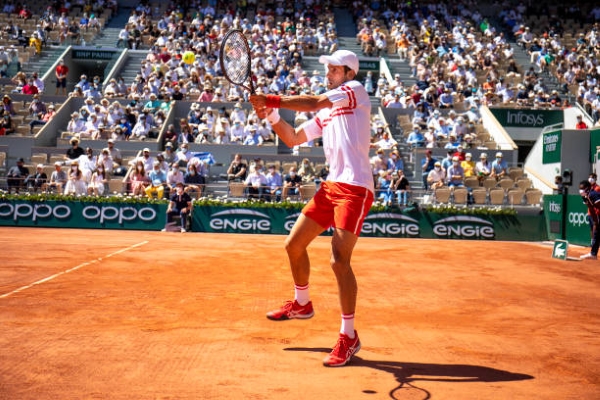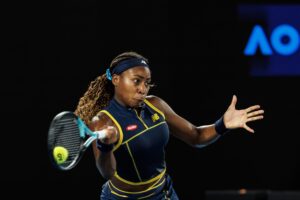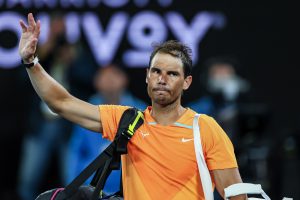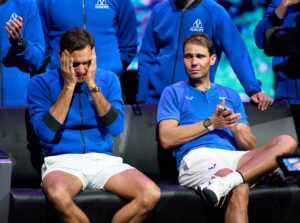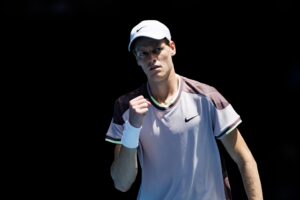Novak Djokovic played some of the best tennis of his career in 2021. In fact, his 2021 will go down as one of the best in tennis history. Aged 34, and with the next generation of players breaking through at the top of the game, the Serb continued to raise the bar in 2021, culminating in a season that saw him win the first three Grand Slam of the year and achieve the year-end #1 ranking for a record seventh time.
Novak Djokovic 2021 Season Review
Familiar Dominance in Unfamiliar Circumstances
Australia has long been the happiest of hunting grounds for the world #1 and Djokovic began his season down under at the ATP Cup, which has now become the sport’s most competitive and engaging team competition. Serbia headed into the event as the defending champions and Djokovic was immediately put under pressure and faced two tough competitive singles matches to begin the season. The first of these came against Denis Shapovalov, a player who has both great firepower and unpredictability, making him a difficult player to come up against. The match was a high quality one, with Djokovic prevailing in straight sets 7-5 7-5.
The Serb later partnered with Filip Krajinovic as they defeated Shapovalov and Milos Raonic in the deciding doubles rubber to secure the tie for Serbia. Next on the agenda was Germany, and a chance for Djokovic to renew his rivalry with Alexander Zverev. This rivalry has become one of the most entertaining and intriguing in recent years. Although the head to head currently stands at 7-4 to Djokovic, if we take best-of-five sets out of the equation and focus purely on best-of-3, the head to head is tied at four apiece. Their match at the ATP Cup was another close encounter. The German took a tight first set on the tiebreak, winning it 7-3. Djokovic bounced back in the second set winning it 6-2, setting up a final set decider.
Both players served well, however it was Djokovic who played the stronger tennis in the crucial high pressure moments, and he took the final set 7-5. Although Djokovic and compatriot Nikola Cacic lost to Jan-Lennard Struff and Zverev in the doubles, thus knocking Serbia out of the competition, the ATP Cup proved to provide the perfect preparation for the first Major of the year at Melbourne Park.
The 2021 Australian Open will live long in the memory for a number of reasons. From players sharing videos of their hotel room practice routines, to crowds being told to leave the grounds of Melbourne park due to a state lockdown being imposed midway through the tournament, it was a Grand Slam tournament like no other.
The world #1 began his Australian Open under the lights of the Rod Laver Arena against Jeremy Chardy, and immediately sent out a strong message of intent to the locker room with an emphatic 6-3 6-1 6-2 win. However, Djokovic would by no means have an easy route through the draw. In the second round, Frances Tiafoe provided a strong test and played a great match, taking the second set on a tiebreak. Another tiebreak was required in the third set which Djokovic won before securing the win in four sets. However, it was the Serb’s third round match against Taylor Fritz that was perhaps the most memorable match of the tournament.
The match began in somewhat of a routine fashion, with Djokovic taking a two sets to love lead. However, in the third set the Serbian suffered an abdominal injury and Fritz won the third and fourth sets. The crowd on Rod Laver Arena were forced to leave at 3-2 in the fourth set, a further sign of the incredible circumstances that the tournament was played under. Djokovic fought through his injury and got the win in five sets. In the second week of the tournament, the world #1 dropped a set against Milos Raonic and Alexander Zverev, winning both matches in four sets to reach the semifinals.
From there on in, Djokovic did not drop a set, defeating first time Grand Slam semifinalist Aslan Karatsev in the semifinals and he defeated Daniil Medvedev with surprising ease in the final to lift his ninth Australian Open Title. Medvedev had dispatched Stefanos Tsitsipas in the semifinals, however against Djokovic, the Russian was not able to win the same number of free points on his serve. It had been pretty much the perfect start to the season for the Serb, and more success was to come.
Determination on the Dirt
Novak Djokovic chose to take a prolonged break after his success down under, opting not to play in Miami. The next time the world #1 took to the match court was at the Monte Carlo Country Club for the Monte Carlo Masters. After an impressive win over Jannik Sinner in his opening match, Djokovic put in a disappointing performance against Britain’s Dan Evans, losing 4-6 5-7. Credit must be given to the Brit as his slice and net game made it difficult for the Serb to get into a comfortable rhythm. Against Sinner, Djokovic had been able to exploit the Italian’s predictable serve placement, especially the body serve, however Evans managed to effectively use good variety both on the serve and during the rallies.
After a disappointing Monte Carlo, Djokovic headed home to Belgrade to play the first of the two ATP 250 events being held in Belgrade. It was in the opinion of many, that this would be the week where Djokovic would get his clay court season back on track. After two routine wins over Soon-Woo Kwon and fellow Serb Miomir Kecmanovic, Djokovic faced a rematch of his Australian Open semi-final as he took on Aslan Karatsev. The match would prove to be one of the best matches of the year
.Both players posted incredible numbers on serve, with Djokovic having a 91% first serve percentage and Karatsev’s first serve percentage was even higher at 95%. However, there were many break point chances across three tight sets and perhaps surprisingly, Karatsev won 100% of points on his second serve, a remarkable feat against the greatest returner of a tennis ball our sport has ever seen. In the end, Karatsev was the deserved winner, coming through 7-5 4-6 6-4. With that defeat, there were some who questioned Djokovic’s chances for Roland Garros.
After Belgrade, Djokovic headed to Rome still searching for his best clay court tennis. This week on the courts of the Foro Italico would prove to be instrumental in the Serbian achieving the confidence and level required to win Roland Garros. Djokovic began the week with straight sets wins over Taylor Fritz and Alejandro Davidovich Fokina, however in the quarterfinals he was involved in a dramatic battle with Stefanos Tsitsipas, a match that was played across two days, due to poor weather on the Friday.
Djokovic left the court on Friday afternoon trailing by a set and a break, however on Saturday, the world’s top-ranked man returned reinvigorated, breaking Tsitsipas twice to take the second set. In the decider, Tsitsipas was once again ahead and served for the match at 5-4, however Djokovic’s return game increased in quality and again he rallied back to break the Greek. Djokovic broke Tsitsipas again to win an enthralling encounter 4-6 7-5 7-5. This was the moment that well and truly kick-started the clay court season for the Serb. Despite not being as dominant at the Masters 1000 events and in best-of-three matches as he had been in the past, Djokovic’s resolve and determination to win sent out a strong message to the rest of the field.
This intense battle against the Greek would foreshadow their epic final at Roland Garros the following month. After defeating Lorenzo Sonego later that day in the evening semifinal in three sets, Djokovic faced Rafael Nadal in the final. It was a day of missed opportunities for the world #1, although, in fairness, Nadal played the better tennis in the pressured situations. The Spaniard was more clinical on break points winning 3/6 compared with Djokovic’s 3/8. Nadal also had a better first serve percentage at 75% compared with Djokovic’s 66%. Nadal triumphed 7-5 1-6 6-3. Despite not winning the title in Rome, there were many positives for Djokovic to take into the rest of the season.
Before Roland Garros, Djokovic surprised many with his decision to play the second ATP 250 event in Belgrade. This proved to be an inspired decision, with the world #1 winning the event for the loss of only one set. It built valuable momentum and confidence heading into the second Grand Slam of the year.
At Roland Garros, Djokovic comfortably navigated his way through the opening week of the tournament, defeating Tennys Sandgren, Pablo Cuevas and Ricardas Berankis without dropping a set. However, the second week would prove to be far more testing. Djokovic faced one of the most exciting next-gen players. Lorenzo Musetti in the fourth round. After going two sets to love down, with the Italian playing inspired tennis, Djokovic was able to turn it around his fitness proved to be a key factor, as the Italian ran out of energy and Djokovic won the last three sets convincingly.
After coming through Mateo Berrettini in a tough four set quarterfinal, Djokovic faced Rafael Nadal in the semifinals in what would prove to be one of the best matches of the season. Nadal made a great start to the match and took the opening set. However, Djokovic upped his level and took the second set 6-3. The third set will live long in the memory, with both players producing a ridiculously high level of tennis. The Serb came back from set point down to win what would prove to be a crucial tiebreak. Such was the scale of the sporting genius on display, that the French Government made a special curfew exemption for those inside Court Philippe Chatrier, in order to allow them to stay until the conclusion of the match. Djokovic took the fourth set 6-2 and in doing so became the first ,man in history to have beaten the Spaniard more than once at Roland Garros.
Djokovic faced Stefanos Tsitsipas in the final and it was very clear from the early stages of the match that the Serb was struggling to find his level. Despite this, the first set went to a tiebreak, which the Greek was able to win. In the second set, Tsitsipas played magnificent tennis, whilst it appeared that Djokovic looked physically and mentally exhausted from his semi-final win. Tsitsipas took the second set 6-2 and as a bewildered Djokovic left the court, many thought that the Greek looked set to win his first Grand Slam title.
However, when Djokovic returned to court, he became a different player. Suddenly he began to move better and the unforced errors dissipated. It was as if it was new match, with the Serb’s mental toughness on full display. There was nothing that Tsitsipas could do as Djokovic simply outplayed him in sets three, four and five as he overturned a two sets to love deficit to win his second Major title of the season, becoming the first man since Rod Laver to win all four Grand Slams at least twice in process. This was without a shadow of a doubt the Serb’s greatest and most impressive Grand Slam triumph.
Great on the Grass
Unsurprisingly, Djokovic took a well deserved rest after the clay-court swing. Despite not playing any singles grass court matches in the run up to Wimbledon, the Serb made another inspired decision to play doubles at the ATP Mallorca Open, an ATP 250 grass court event with Spaniard Carlos Gomez-Herrera. Playing doubles allowed the world #1 to practice his net game and overhead, the latter of which is considered to be his weakest shot. It meant he could get valuable grass court preparation, without too much physical exertion. Djokovic reached his first doubles final in over a decade, however the pair were forced to withdraw from the title match due to Gomez Herrera picking up an ankle injury.
At Wimbledon, Djokovic won his sixth title for the loss of only two sets. After dropping the opening set of his title defense to British Wildcard Jack Draper, Djokovic had a relatively scare free run to the final. He was forced to save set point in the third set of a high quality and enjoyable match against Denis Kudla, and Denis Shapovalov was arguably the better player during part of their semifinal match, although crucially was outplayed in the pressure moments. In the final Djokovic faced Matteo Berrettini, the champion at the Queens Club.
Djokovic dropped the opening set and was break point down early on in the second set, however the Serb managed to come through that tight service game, and as the match progressed, Djokovic began to exploit the Berrettini backhand. Djokovic triumphed 6-7 6-4 6-4 6-3. This meant that Djokovic had won the first three Grand Slam titles of the season and he would have the chance to emulate Rod Laver’s 1969 achievement of winning the Calendar slam. However with the Olympic gold Medal also up for grabs, Djokovic was also trying to emulate Steffi Graf’s 1988 season of winning all four Grand Slam titles and Olympic gold in the same season. History was on the line.
Lost But Won
The second half of the season for Novak Djokovic was far less hectic in terms of the schedule. However the pressure on the Djokovic was immense. There were two clear goals, the Olympic Gold Medal and the US Open title. Djokovic chose not to return to court before the Olympics.
The conditions during the Tokyo Olympics were extremely humid, and Djokovic was one of the players who managed to persuade the organizers to play matches later in the day, when the humidity was not as high. On court, Djokovic looked in imperious form. He defeated Hugo Dellien, Jan-Lennard Struff, Alejandro Davidovich Fokina and Kei Nishikori without dropping a set to reach the semi-finals. In the Semifinal with Alexander Zverev, the Serb was leading by a set and a break, and he looked like he would comfortably reach the gold medal match.
However, the German had other ideas. In a combination of Zverev’s brilliance and perhaps the pressure getting to Djokovic, the Serb’s level dropped off a cliff and as quickly as he had found himself a set and a break up, Djokovic lost the second set 3-6 and lost the third quickly 1-6. It was an astonishing upset and full credit must be given to Zverev, who went on to win the gold medal in the men’s singles. It was heartbreak for Djokovic. Pablo Carreno Busta defeated Djokovic in the Bronze medal match, with the Spaniard in inspired form.
The world #1, to the surprise of many also chose to compete in the mixed doubles Nina Stojanovic. The pair reached the Bronze medal match, however Djokovic withdrew from the match. This was arguably one of the most disappointing weeks in the Serb’s career.
At the US Open, Djokovic battled through a difficult draw to reach the final. In a contrast to the first three Grand Slam events of the season, Djokovic dropped many sets en route to the final. He dropped sets to Rune, Nishikori, Brooksby and Berrettini before his semi-final with Alexander Zverev, thus unlike at Roland Garros, Djokovic did not have energy reserves to rely on at the end of the second week. The Semi-final was a five set epic, however this time Djokovic came out on top, partly due to the fact that he was more clinical on break points than the German. Djokovic converted 6/9 break point chances compared to Zverev who only managed to convert 3/12 break point chances.
In reaching the final, Djokovic was one match away from history. Daniil Medvedev would be Djokovic’s opponent, a rematch of the Australian Open final. However, this time the Russian dominated the Serb. Medvedev executed a brave and bold tactic to perfection. He went big on his second serves, not allowing Djokovic to get into a rhythm on return. Medvedev dominated the baseline exchanges and won the match comfortably 6-4 6-4 6-4 to win a much deserved first Grand Slam title.
This brings us to the title of this segment. In the final change of ends before Medvedev served out the match, the crowd showed their appreciation to the world #1 by cheering and chanting his name. Such scenes had not been witnessed since Djokovic was defeated by Stan Wawrinka at Roland Garros in 2015. Djokovic was visibly emotional.
The crowd who had treated him the worst and had been particularly hostile to him during the 2015 US Open final against Federer were now fully behind him. He may have lost the title, but Djokovic had finally won over the crowd and now had their respect. The pressure had finally left Djokovic and he could now reflect on what had been an historic season. The world #1 won the Paris Masters and reached the semifinals of the Nitto ATP Finals in Turin, losing to Zverev. Djokovic also represented Serbia in the Davis Cup, winning all his singles matches.
Conclusion
Whatever happens in the rest of Novak Djokovic’s career, his 2021 season will live long in the memory as being one of the most historic and enthralling season’s in the sport. We may never against witness a player win the Australian Open, Roland Garros and Wimbledon in the same season. This further cements his place at the top of our sport and as arguably the greatest player of this greatest of generations.
Main photo:
Embed from Getty Images


